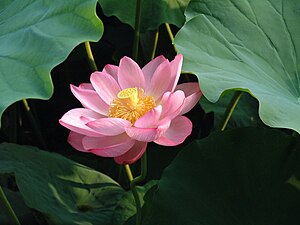
Lakshmi also known as Shri, is one of the principal goddesses in Hinduism. She is the goddess of wealth, fortune, power, beauty, fertility and prosperity, and associated with Maya ("Illusion"). Lakshmi is the supreme goddess in Vaishnavism. She along with Parvati and Saraswati, forms the Tridevi.

Mount Meru, also known as Sumeru, Sineru, or Mahāmeru, is the sacred five-peaked mountain of Hindu, Jain, and Buddhist cosmology and is considered to be the centre of all the physical, metaphysical, and spiritual universes. The mountain is also mentioned in some scriptures of non-Indian based religions such as Taoism, which was influenced by the arrival of Buddhism in China. There is no clear identification of Mount Meru with a particular geophysical location but it is always located in Himalayan or Aravali ranges.

Kubera also known as Kuvera, Kuber and Kuberan, is the god of wealth, and the god-king of the semi-divine yakshas in Hinduism. He is regarded as the regent of the north (Dikpala), and a protector of the world (Lokapala). His many epithets extol him as the overlord of numerous semi-divine species, and the owner of the treasures of the world. Kubera is often depicted with a plump body, adorned with jewels, and carrying a money-pot and a club.

Saraswati, also spelled as Sarasvati, is the Hindu goddess of knowledge, music, flowing water, abundance and wealth, art, speech, wisdom, and learning. She is one of the Tridevi, along with the goddesses Lakshmi and Parvati. She is a pan-Indian deity, also revered in Jainism and Buddhism.
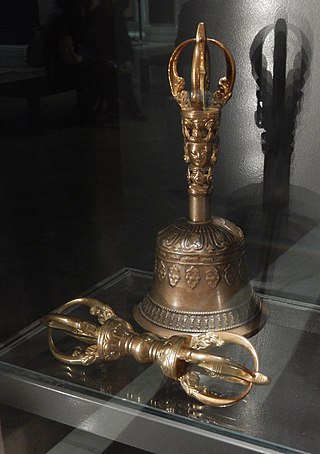
The Vajra is a legendary and ritualistic tool, symbolizing the properties of a diamond (indestructibility) and a thunderbolt. In Hinduism, it has also been associated with weapons.

Buddhist symbolism is the use of symbols to represent certain aspects of the Buddha's Dharma (teaching). Early Buddhist symbols which remain important today include the Dharma wheel, the Indian lotus, the three jewels and the Bodhi tree.
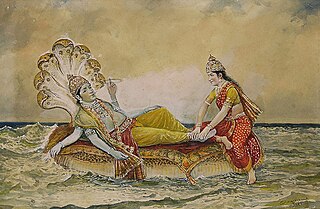
Narayana is one of the forms and epithets of Vishnu. In this form, the deity is depicted in yogic slumber under the celestial waters, symbolising the masculine principle and associated with his role of creation. He is Brahman, the Ultimate reality and also known as Purushottama, and is considered the Supreme Being in Vaishnavism.

The Shrivatsa is an ancient symbol, considered auspicious in Hinduism and other Indian religious traditions. It is said that the Shrivatsa symbol appears on the chest of an avatar of Vishnu when he is chosen to be Vishnu's incarnation
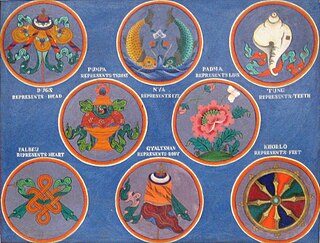
The Ashtamangala is a sacred suite of Eight Auspicious Signs featured in a number of Indian religions such as Hinduism, Jainism, and Buddhism. The symbols or "symbolic attributes" are yidam and teaching tools. Not only do these attributes point to qualities of enlightened mindstream, but they are the investiture that ornaments these enlightened "qualities". Many cultural enumerations and variations of the Ashtamangala are extant.

Kaumodaki is the gadā (mace) of the Hindu deity Vishnu. Vishnu is often depicted holding the Kaumodaki in one of his four hands; his other attributes are the chakra, the conch and the lotus. The gada is also found in the iconography of some of Vishnu's avatars.

The Shri Sukta(Sanskrit: श्रीसूक्तम्, romanized: Śrīsūktam), also called the Shri Suktam, is the earliest recorded Sanskrit devotional hymns that revere Shri-Lakshmi, the Hindu goddess of wealth, prosperity, and fertility. The Shri Sukta is recited, with a strict adherence to Sanskrit prosody for the veneration of the goddess. This hymn is found in the Rigvedic khilanis, which are appendices to the Rigveda that can be dated back to the pre-Buddhist era.
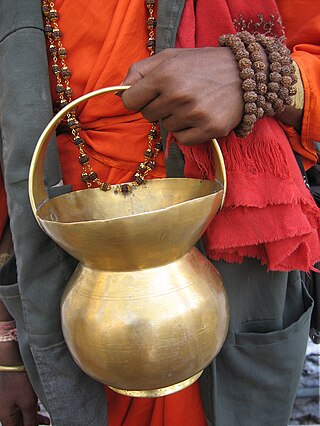
Kamandalu, kamandal, or kamandalam is an oblong water pot, originating from the Indian subcontinent, made of a dry gourd (pumpkin) or coconut shell, metal, wood of the Kamandalataru tree, or from clay, usually with a handle and sometimes with a spout. Hindu ascetics or yogis often use it for storing drinking water. The water-filled kamandalu, which is invariably carried by ascetics, is stated to represent a simple and self-contained life.

Vishnu, also known as Narayana and Hari, is one of the principal deities of Hinduism. He is the supreme being within Vaishnavism, one of the major traditions within contemporary Hinduism.
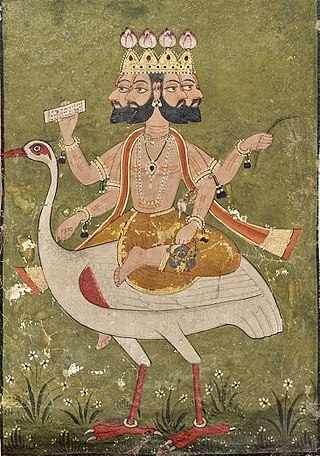
Brahma is a Hindu god, referred to as "the Creator" within the Trimurti, the trinity of supreme divinity that includes Vishnu and Shiva. He is associated with creation, knowledge, and the Vedas. Brahma is prominently mentioned in creation legends. In some Puranas, he created himself in a golden embryo known as the Hiranyagarbha.

Over the millennia of its development, Hinduism has adopted several iconic symbols, forming part of Hindu iconography, that are imbued with spiritual meaning based on either the scriptures or cultural traditions. The exact significance accorded to any of the icons varies with region, period and denomination of the followers. Over time some of the symbols, for instance the Swastika has come to have wider association while others like Om are recognized as unique representations of Hinduism. Other aspects of Hindu iconography are covered by the terms murti, for icons and mudra for gestures and positions of the hands and body.

A kalasha, also called Pūrṇa-Kalaśa, Pūrṇa-Kumbha, Pūrṇa-Ghaṭa, also called ghat or ghot or kumbh, is a metal pot with a large base and small mouth. It is employed in the rituals in Hindu, Jain, and Buddhist traditions as a ceremonial offering to the deity or to an honoured guest and as an auspicious symbol used to decorate shrines and buildings.

Lalitasana is a pose or mudra in Indian art and the art of dharmic religions in other countries. It is often called "the royal position" or "royal ease" in English, and is a relaxed pose typical in royal portraits and those of religious figures whose "kingly" attributes are being emphasized. The figure sits on a throne with one leg tucked inwards on the seat and the other hanging down ("pendent") to touch the ground or rest on a support. Usually it is the proper right leg that dangles, but the reversed image can be found. Bare feet are normal. Asana is a general term for a seated pose, from Sanskrit: आसन āsana "sitting down", a sitting posture, a seat.

The lotus throne, sometimes called lotus platform, is a stylized lotus flower used as the seat or base for a figure in art associated with Indian religions. It is the normal pedestal for divine figures in Buddhist art and Hindu art, and often seen in Jain art. Originating in Indian art, it followed Indian religions to East Asia in particular.

Padma is one of the four attributes borne by Vishnu in his iconography. It is associated with Vishnu's abode upon water, as well as his role in creation and birth.
